Throughout the COVID-19 pandemic, the Federal Reserve Bank and Congress have taken unprecedented steps to stabilize the economy after entire industries and sectors ground to a halt last year amidst the public health crisis. The Fed has kept interest rates near zero, created lending programs to pump trillions of dollars into the economy, and bought securities to support financial markets. Congress passed three major COVID-19 stimulus packages in response to the crisis: the $2.2 trillion CARES Act in March 2020, the $900 billion Coronavirus Response and Relief Supplemental Appropriations Act in December 2020, and the $1.9 trillion American Rescue Plan in March 2021.
These actions helped American households and businesses weather the pandemic in better financial shape than many would have predicted when COVID-19 lockdowns began last March. While millions remain out of work and many businesses have shuttered or remain on the brink, some sectors of the economy easily adapted to COVID-19 and many households—especially higher earners—saw their wealth grow from increased savings, robust government stimulus, and strong stock market returns. And as life in the United States returns to normal, pent-up demand has lifted hard-hit sectors like transportation, retail, tourism, and hospitality this summer.





